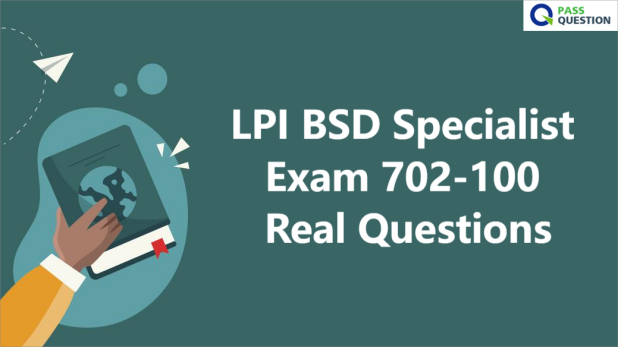
LPI BSD Specialist Exam 702-100 Real Questions
If you are interested in obtaining the Linux Professional Institute BSD Specialist Certification, PassQuestion provides a wide range of resources to support your journey. We offer high-quality LPI BSD Specialist Exam 702-100 Real Questions that are specifically designed to help you succeed. Our comprehensive LPI BSD Specialist Exam 702-100 Real Questions are carefully crafted to ensure that you not only pass the final 702-100 certification test but also excel in it on your very first attempt. With our LPI BSD Specialist Exam 702-100 Real Questions, you can confidently prepare for and ace the exam, setting yourself up for success in your career as a BSD Specialist.

Linux Professional Institute BSD Specialist
The BSD Specialist certification is part of the Linux Professional Institute's Open Technology certification program. It assesses practical skills required to work effectively with FreeBSD, NetBSD, or OpenBSD environments and administer BSD operating systems. The typical BSD Specialist certification holder is a system administrator specializing in BSD operating systems. They have a solid understanding of BSD system architecture and can manage various aspects of a BSD installation, including user accounts, processes, file systems, software installation, and client networking. Candidates are also experienced in using standard BSD and Unix command line tools.
To obtain the BSD Specialist certification, candidates need to possess a solid understanding of BSD operating systems such as FreeBSD, NetBSD, and OpenBSD. They should be capable of installing, managing, and configuring these operating systems, as well as configuring hardware, adjusting kernel parameters, and ensuring system security. Additionally, candidates should have a foundational understanding of BSD system administration, including job scheduling and system automation, along with basic knowledge of network administration.
BSD Specialist Exam 702 Details
Current Version: 1.0 (Exam code 702-100)
Prerequisites: There is no prerequisite certification for taking the BSD Specialist Engineer exam. However, it is strongly recommended that a candidate has more than a year of experience in administering BSD systems of various kinds.
Requirements: Pass the BSD Specialist exam. The 90 minute exam is 60 multiple choice and fill-in-the-blank questions.
Validity Period: 5 years
Languages: English
BSD Specialist Exam 702 Objectives
BSD Installation and Software Management
- BSD Operating System Installation
- BSD Software and Package Management
- BSD System Startup Configuration
- Hardware Configuration
- BSD Kernel Parameters and System Security Level
Storage Devices and BSD Filesystems
- BSD Partitioning and Disk Labels
- Create File Systems and Maintain their Integrity
- Control Mounting and Unmounting of File Systems
- Manage File Permissions and Ownership
- Create and Change Hard and Symbolic Links
- Find Files and BSD Directory Layout
Basic BSD System Administration
- Manage User Accounts and Groups
- Automate System Administration Tasks by Scheduling Jobs
- Maintain System Time
- System Logging
- Mail Transfer Agents (MTA) Basics
- Manage Printing and Print Jobs
- Manage User Sessions
Basic BSD Network Administration
- Fundamentals of Internet Protocols
- Basic network configuration
- Basic network troubleshooting
- Configure Client Side DNS
Basic Unix Skills
- Use the Shell and Work on the Command Line
- Perform basic file management
- Create, Monitor and Kill Processes
- Use Simple Regular Expressions
- Perform basic file editing operations
- Customize or write simple scripts
View Online Linux Professional Institute BSD Specialist 702-100 Free Questions
1. Which of the following commands creates a ZFS snapshot of the dataset space/data named snap1?
A.zfs snapshot space/data@snap1
B.zfs reflink space/data snapl@space/data
C.zfs copy -s space snap1
D.zfs shadow space/data space/data/snap1
E.zfs create space/data: snap1
Answer: A
2. Which device stands for the first BSD disk slice in the disk label on the first partition on the second SATA disk on OpenBSD?
A./dev/sdla
B./dev/d2sl
C./dev/slld2
D./dev/sdlp2d
E./dev/sata2a
Answer: E
3. When creating a symbolic link, an error message indicating that the target already exists is displayed. Which statement is true?
A.In can not override an existing target so the target must be manually removed
B.In can override the target, but only if it is a file.
C.In can override the target, but only if it is a directory
D.In can override the target, whether it is a file or a directory.
E.In can not override an existing symbolic link.
Answer: A
4. Which of the following commands have to be used in order to update FreeBSD? (Choose TWO correct answers.)
A. freebsd-update repoupdate
B. freebsd-update fetch
C. freebsd-update install
D. freebsd-update resoivedeps
E. freebsd-update all
Answer: B,C
5. Which file defines the IP address of the default gateway on a FreeBSD system?
A. /etc/resolvers
B. /etc/network
C. /etc/rc.conf
D. /etc/red
E. /etc/gateway
Answer: C
6. When replacing the system MTA with another mail server program, which configuration file needs to be updated with the path to the new MTA?
A. sendmail. conf
B. postfix.conf
C. mail.conf
D. mailer.conf
E. mta.conf
Answer: D
SIIT Courses and Certification
Also Online IT Certification Courses & Online Technical Certificate Programs

